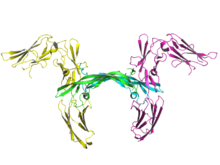Platelet-derived growth factor receptor
This article needs additional citations for verification. (November 2019) |
| Platelet-derived growth factor receptor | |||||||||
|---|---|---|---|---|---|---|---|---|---|
 | |||||||||
| Identifiers | |||||||||
| Symbol | PDGFR | ||||||||
| Pfam | PF04692 | ||||||||
| InterPro | IPR006782 | ||||||||
| Membranome | 1204 | ||||||||
| |||||||||
Chr. 4 q12 | |||||||
|---|---|---|---|---|---|---|---|
| |||||||
Chr. 5 q31-q32 | |||||||
|---|---|---|---|---|---|---|---|
| |||||||
Platelet-derived growth factor receptors (PDGF-R) are cell surface
alpha and beta each encoded by a different gene.[3] Depending on which growth factor is bound, PDGF-R homo- or heterodimerizes.[4]
Mechanism of action
The PDGF family consists of PDGF-A, -B, -C and -D, which form either homo- or hetero
immunoglobulin-like domains while the intracellular part is a tyrosine kinase domain. The ligand-binding sites of the receptors are located to the three first immunoglobulin-like domains. PDGF-CC specifically interacts with PDGFR-αα and -αβ, but not with -ββ, and thereby resembles PDGF-AB. PDGF-DD binds to PDGFR-ββ with high affinity, and to PDGFR-αβ to a markedly lower extent and is therefore regarded as PDGFR-ββ specific. PDGF-AA binds only to PDGFR-αα, while PDGF-BB is the only PDGF that can bind all three receptor combinations with high affinity.[5]
Dimerization is a prerequisite for the
substrates
for the kinase.
Expression of both receptors and each of the four PDGFs is under independent control, giving the PDGF/PDGFR system a high flexibility. Different cell types vary greatly in the ratio of PDGF isoforms and PDGFRs expressed. Different external stimuli such as embryonic development
or differentiation modulate cellular receptor expression allowing binding of some PDGFs but not others. Additionally, some cells display only one of the PDGFR isoforms while other cells express both isoforms, simultaneously or separately.
Interaction with signal transduction molecules
Tyrosine phosphorylation sites in growth factor receptors serve two major purposes—to control the state of activity of the kinase and to create binding sites for downstream
Phosphotyrosine
Binding Domains (PTB). The specificity of these interactions appears to be very high, since mutant receptors carrying phenylalanine residues in one or several of the different phosphorylation sites generally lack the capacity to bind the targeted signal transduction molecule. The signal transduction molecules are either equipped with different enzymatic activities, or they are adaptor molecules, which in some but not all cases are found in complexes with subunits that carry a catalytic activity. Upon interaction with the activated receptor, the catalytic activities become up-regulated, through tyrosine phosphorylation or other mechanisms, generating a signal that may be unique for each type of signal transduction molecule.
Examination of the different
RTKs established Ras/mitogen-activated protein kinase (MAPK), PI-3 kinase, and phospholipase-γ (PLCγ) pathways as key downstream mediators of PDGFR signaling.[7][8] In addition, reactive oxygen species (ROS)-dependent STAT3 activation has been established to be a key downstream mediator of PDGFR signaling in vascular smooth muscle cells.[9]
MAPK pathway
The adaptor protein Grb2 forms a complex with Sos by the Grb2
immunoresponses
.
PI3K pathway
The class IA phospholipid kinase, PI-3 kinase, is activated by the majority of RTKs. Similarly to other SH2 domain-containing proteins, PI-3 kinase forms a complex with PY sites on activated receptors. The main function of
phosphotyrosine
sites of the receptor. After activation, PLCγ hydrolyses its substrate PtdIns(4,5)P2 and forms two second messengers, diacylglycerol and Ins(1,4,5)P3. Ins(1,4,5)P3 stimulates the release of Ca 2+ from intracellular supplies. Ca 2+ then binds to calmodulin, which subsequently activates a family of calmodulindependent protein kinases (CamKs). In addition, both diacylglycerol and Ca 2+ activate members of the PKC family. The second messengers generated by PtdIns(4,5)P2 hydrolysis stimulate a variety of intracellular processes such as proliferation, angiogenesis, cell motility.
See also
- Receptor tyrosine kinase
- PDGF
- Imatinib
- PDGFRA
- PDGFRB
- Crenolanib (CP-868,596-26)
References
External links
- Platelet-Derived+Growth+Factor+Receptors at the U.S. National Library of Medicine Medical Subject Headings (MeSH)
